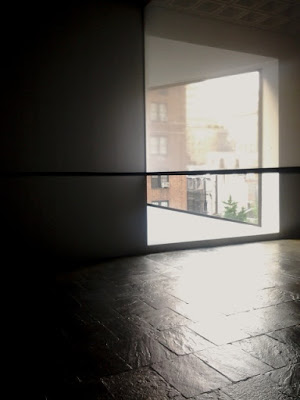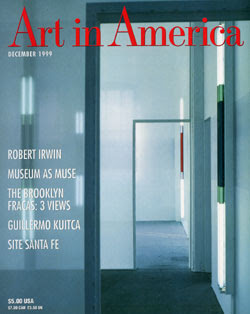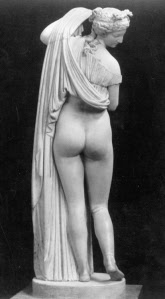Robert Irwin
Art Vent Letting the Fresh Air In
CD: I wrote in my post that the window, whose black frame roughly matches the elements you added, appeared to be your starting point. Is that so?
Robert Irwin, Museum of Contemporary Art, Chicago, 1975.
Further reading: Carol Diehl, "Robert Irwin: Doors of Perception," Art in America, December, 1999.
Olafur Eliasson, weather project (2003), Tate Modern
Frustration and contemplation, however, do not go together.
PART II Robert Irwin on "Scrim Veil-Black Rectangle-Natural Light (1977)" recently at the Whitney
Further reading:
Roberta Smith on Turrell "New Light Fixture for Famous Rotunda" and Irwin "Ineffable Emptiness: From Dawn to Dusk"
Gabrielle Selz "Considering Perception: Robert Irwin and James Turrell": a look at their shared history.
Lee Rosenbaum: "Turrell's Skyspace Obscures the Sky"
Blake Gopnik: "Has the Sage Turrell Sold Out?"
(Also note that the people in the publicity shot above, courtesy of the gallery, are NOT wearing booties.)
I said I didn’t want to go see art (“I’m here to see you”) but son Matt insisted and anyone who knows Matt knows that when he insists, it’s futile to protest. Besides he was right, as he usually is.
Our first stop was 
 Oh, and the chilled soup I got at the museum cafe in the courtyard. You can try this at home: beet puree mixed with watermelon juice and a touch of finely chopped mint. Perfect!
Oh, and the chilled soup I got at the museum cafe in the courtyard. You can try this at home: beet puree mixed with watermelon juice and a touch of finely chopped mint. Perfect!
 Christmas lights, Great Barrington, MA, December 2008
Christmas lights, Great Barrington, MA, December 2008"What the cynics fail to understand, is that the ground has shifted beneath them."--President Obama's inaugural address.
I started writing this a month ago, but was so bored I didn't finish, because it's just too boring to write about being bored. But truly, since returning from Berlin in November, I've not been able to get interested in art, which is a problem considering that it's not only my field, but too late in life to take up another profession--such as plumbing or neurobiology, or become a concert pianist after all. However either out of habit or false hope, I've continued to trudge around to museums and galleries looking for inspiration, not just to write about, but for my studio practice, which is in need of a reboot.
What first set me on the road to ennui was Eleanor Antin, The King, 1972 (image from the Web)
 Eleanor Antin, The Angel of Mercy (Florence Nightingale), Myself-1854, 1977 (Image from the Web)
Eleanor Antin, The Angel of Mercy (Florence Nightingale), Myself-1854, 1977 (Image from the Web)After that it was the Institute of Contemporary Art (ICA) in Boston, a museum I want desperately to like, whose new building (and admission fee—$12 per person plus $11 or more for parking) sets off all kinds of expectations that, so far, have not been met by what’s inside. This time the main show was Tara Donovan, who makes installations with mass-produced disposable objects, such as plastic cups and toothpicks. I can see how the idea might be interesting (“Ooh, Honey, did you realize this is made of plastic straws?”) to someone who hasn’t taught a gazillion graduate students. In my experience, at least one third of the graduate population has latched onto similar ideas as a way of getting out of actually making something without having to spend much money or travel farther than the nearest convenience store (I wish I had a dollar for every piece of art I’ve seen made of black plastic garbage bags). Then there’s the text that suggests that because Donovan has figured out a way to make a cube out of metal sewing pins, she’s part of a lineage that includes Donald Judd—with whom she has about as much in common as Santa Claus.
Which brings me to one of my favorite subjects: wall text (some of my readers may already be aware of my promise to abolish it, along with artist statements, when I’m king). I’m clueless as to why such a small museum would give over any space to a permanent collection, but if they do, they’d better make sure it stands up to multiple viewings. This one threatens to become a Saatchi-esque time capsule, with texts that read like exercises one might be required to write in curator school. This, for instance, next to a painting that appears equally academically-driven:
Untitled continues Lucy McKenzie's exploration of latent meanings in design styles, expanding a detail from an advertising image she found on a condom vending machine of two robots amorously engaged. The scene is rendered in a Mondrian-esque style using geometric blocks and is rendered in faux marble to make the "ugly" scene appear more elegant. The work also includes two figures in shadow, as if in conversation while looking at the painting.
And back in New York, at the New Museum, while Elizabeth Peyton's paintings were charming, did they justify this curator's paean?
Where her earliest portraits can be compared to those of Dutch masters or Spanish painters in their quietude and focus on the aspect of a single subject in the center of the picture plane, beginning in the 2000s, Peyton's maturity as a painter is expressed in the increasing complexity of her compositions. In the history of portraiture, these later works can be more closely compared to figure compositions by Henri Matisse or Eduard Vuillard, both of whom integrated their human subjects with their static ones in dense surfaces of pattern and brilliant color.
But what finished me off was the Marlene Dumas painting exhibition at MoMA (through February 16th). As Peter Schjeldahl wrote in The New Yorker:
She has been favored by a fashion for sensationalized moral seriousness which explains the recent prestige of Francis Bacon and Lucian Freud and of younger masters of sardonic melancholy, including Luc Tuymans of Antwerp, and Neo Rauch of Leipzig. Is this taste a self-flagellating compunction of the spendthrift rich? Surely no one would paint pictures as aggressively uningratiating as those of Dumas unless she meant them.
Well, I don't care whether she means it or not, the "artist's intention" holds little interest for me, only the result--which here, despite Schjeldahl's rhapsody over Dumas's brushwork, is heavy-handed and depressing. I’m not opposed to so-called “serious” subject matter, but a little nuance would be nice. Interestingly, in that same New Yorker, David Denby reviews the film “Revolutionary Road,” and while finding it “honorably and brutally unnerving,” suggests that it “may suffer…from the illusion that pain and art are the same thing.” He could have been writing about Dumas.
After that I was sure I never wanted to see any more art ever again.
Later I began to think that my reaction had to do with the sense that the art I was seeing was looking old, because--in case you haven’t noticed--we’re in the midst of a great cultural shift. And unlike generations in the past who experienced the massive change that came with the invention of the printing press or the rise of the Industrial Revolution, we know it, can feel and see it. It’s fast, so fast that when I was working with the art director on TIME’s Person of the Year, he noted that if we had commissioned a portrait of Obama in October, it wouldn’t be the one we’d want to run in December. And the Tom Friedman piece of December 23rd that I wanted to link to when I started writing this, Time to Re-Boot America now feels as if it was penned a year ago rather than just a month or so.
It’s a time of purging, of getting rid of what doesn’t work and replacing it with…well we don’t know. But it’s inevitable that art will change with it, old systems will be replaced with new ones, and that which doesn’t deliver, will fail.
And while I don't have a crystal ball, I'll make some predictions just because this is my blog and I can. I believe that in the future (which, the way things are going, could be next week) we’re going to be less fascinated with human dysfunction (a la Dumas and Sherman) and seek more art that inspires us, has substance, puts us in awe of human capability. I hope that we’ll also figure out another way of experiencing art that doesn’t involve rectangular rooms, white walls, and track lighting. I want art to engage and involve, be more than this static thing that we look at while standing on our feet (although I dislike so-called “interactive art" even more), but has to do with its context and, like music, is woven into the fabric of our lives. I believe the era of the individual genius is waning, and instead collaborative ventures (between individuals as well as disciplines) will come to the forefront. That means chucking the our current system of teaching visual art, which has hardly changed for centuries (okay, so we teach “media arts” now, it’s still a separate department) and move toward one that’s integrated with science, mathematics, agriculture, history, and technology, as well as the other arts.
I also believe people will always be fascinated with painting.
With these thoughts in mind, I went to Chelsea yet again, and this time saw two exhibitions that looked not only far from tired, but fresh and new. The irony is that one was done by an 80-year-old, Robert Irwin, and the other by Fred Sandback who, were he still alive, would be in his mid-sixties. Both installations are serene, sure, engaging and beautiful. Oh, did I mention beauty? Well I believe in beauty, and think it’s a human need, as important as fresh air and water. It's definitely due for a comeback.
 Installation view of Robert Irwin's Red Drawing White Drawing Black Painting, on view at PaceWildenstein, 545 West 22nd Street, NYC through February 28, 2009. Photo by G.R. Christmas/Courtesy Pace Wildenstein, New York.
Installation view of Robert Irwin's Red Drawing White Drawing Black Painting, on view at PaceWildenstein, 545 West 22nd Street, NYC through February 28, 2009. Photo by G.R. Christmas/Courtesy Pace Wildenstein, New York.These images , however, hardly convey the experience of being there, which is why Irwin, in the early days, refused to have his work photographed.
And Shepard Fairey is, for sure, of his/our time. Creator of the now iconic image of Obama that became so important to the campaign—as symbolic of our decade as Robert Indiana's Love was to the 60’s—the attention given him now is well-deserved. I knew about Fairey’s work through my son, Matt, and last year suggested to TIME that they commission him to do a portrait of the 2007 Person of the Year, Vladimir Putin, which ran on the inside of the magazine:
 Vladimir Putin by Shepard Fairey for TIME, 2007
Vladimir Putin by Shepard Fairey for TIME, 2007This year TIME invited Fairey to do another image of Obama (see video) for the cover, and it's every bit as strong as the first--and updated, more "now" than last year's poster. What I especially like about Fairey’s new fame--in this time of fallout from extreme greed--is that it stems from an image he gave away (which is why I think the current copyright flap won't hold water--as a picture-researcher friend, put it: "Since the poster/image took on a life of it's own, was 'used' by so many people without even Fairey's permission... how could one begin to determine a use fee?").
 Barack Obama by Shepard Fairey for TIME, 2008
Barack Obama by Shepard Fairey for TIME, 2008And now the ICA in Boston (so critized above) is on its way to redeeming itself in my eyes by being smart enough to mount the first museum survey of Fairey's work, which opens tomorrow and runs through August 16th.
In our rush to control our children’s experience, we forget that people sometimes learn most from attempting to do those things for which they’re not naturally gifted.
As a child, my most obvious talents were musical, and although I studied classical piano for 20 years, I turned out to be an artist—no doubt because, not in spite of, of the challenges art continues to present.
I don’t practice yoga because I’m naturally flexible, but because I’m not.
In Lawrence Wechsler’s biography of Robert Irwin, Seeing is Forgetting the Name of the Thing One Sees, Irwin says:
In my years…as a teacher, I’ve seen it over and over again. It’s the kids with the greatest facility who can run up against the biggest problems. You are the best in your class without even trying, which is the best way to learn nothing…The not-so-facile kid just plugs along, every step is a working step, and he comes to the twentieth step and it’s just another step. But facility is a funny thing—it takes you way up, you soar, and you look like you’re really doing something—but at a certain point you go as far as you can with facility, and then you hit the big questions. And for you, who’ve never been pressed, that can present a huge roadblock. I’ve seen a lot of kids get waylaid at this point…
I’m convinced children are best served when the quality of their effort is applauded, rather than their success. ("The process is the reality," as Samuel Johnson said.) And because there’s a Times article to back up every opinion, here’s Praise Children for Effort, Not Intelligence, Study Says, from 1998.
 James Turrell's Roden Crater
James Turrell's Roden CraterHowever along with deconstruction, we lost our ability to discern. We went rollicking off in the other direction, making deconstruction an excuse for sloppy thinking, sloppy execution, sloppy everything. And I lay much of the blame for this on the proliferation of art schools who profit by making everybody think art is easier than it is, who in order to exist, need the majority of students to come away with a positive experience. I remember a final graduate crit at SVA, when I said to a student about her sculpture, “There’s a lifetime of work to be mined from this”—thinking that I was giving her my highest praise—and she burst into tears because to her mind, she was finished. This was it. What, she’d have to do more?
However I believe the resounding failure of the Whitney Biennial marks the beginning of the end of a too-long era. It goes along with the political scene. We want substance. As with the Iraq war, SUVs, and Froot Loops, we’re not inclined to think something is good for us just because the powers that be say it’s so. I’m encouraged by the fact that I’ve seen more good art in the past six months than in the last ten years put together—and that we’re having these conversations. Before when I saw stuff like Fritz Haeg's Animal Estates or the Whitney’s publicity I thought that I was the only one who thought it was ridiculous. It’s a relief to learn that I’m not alone.













